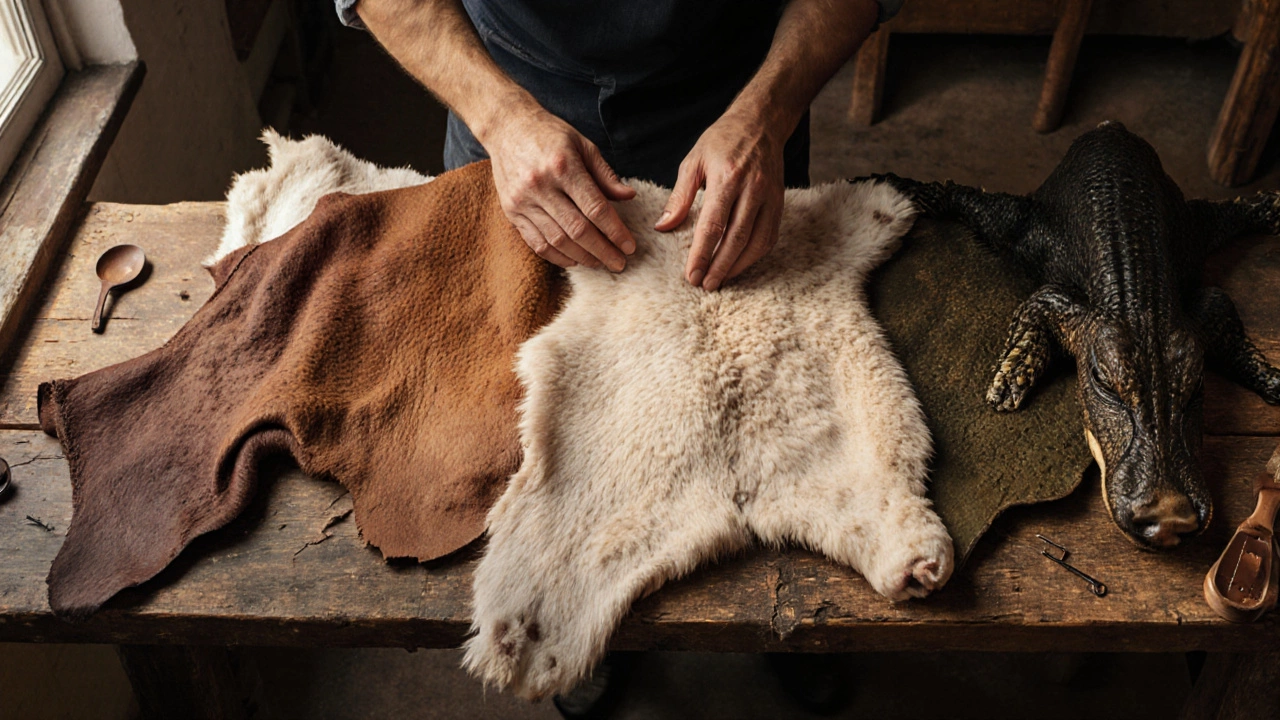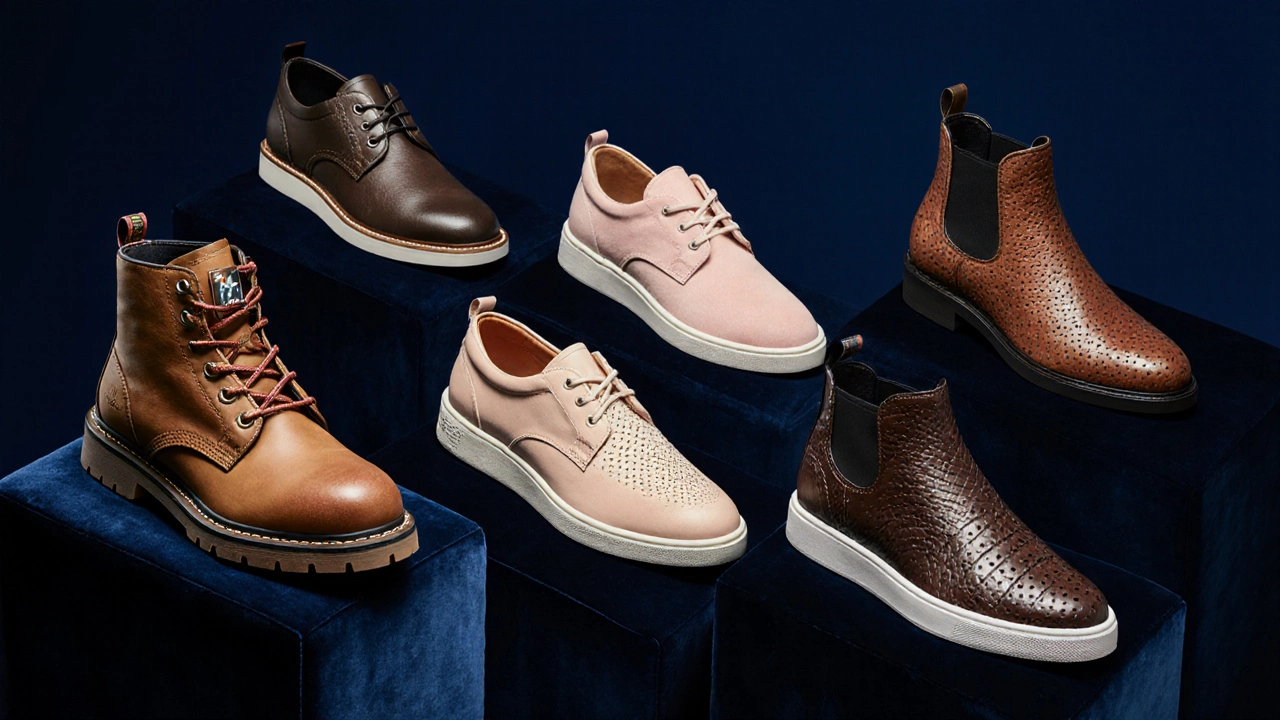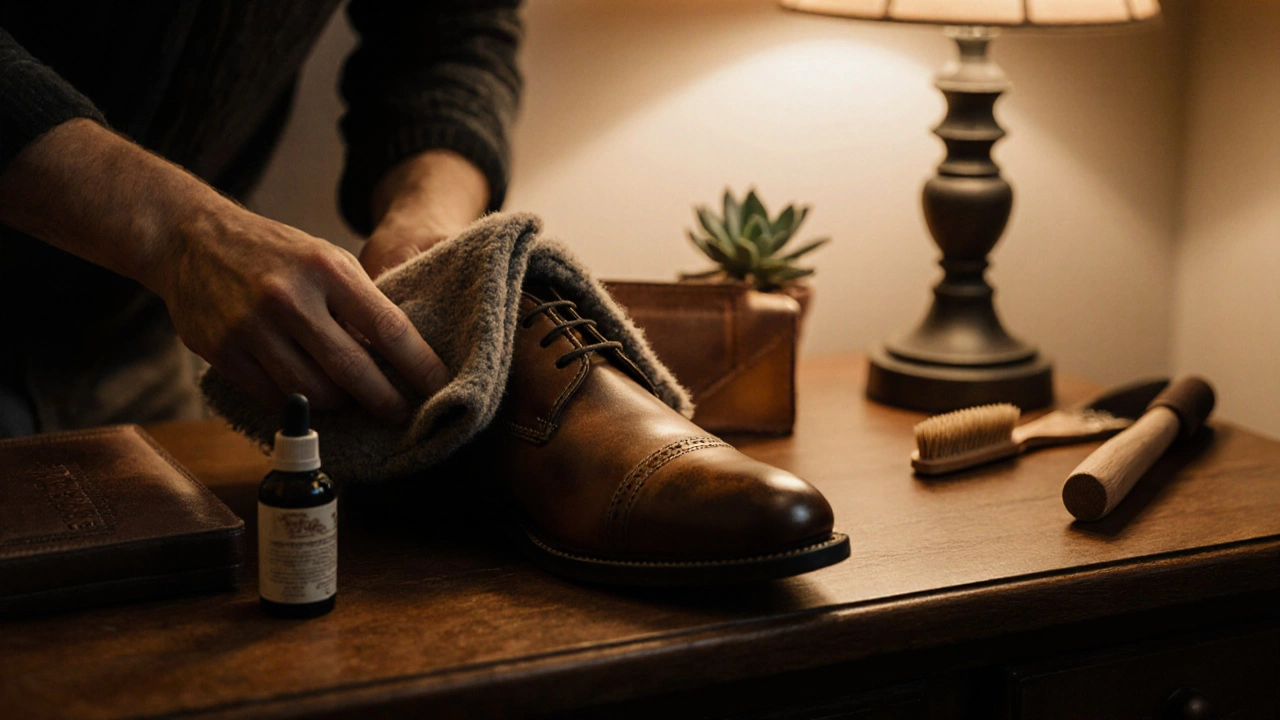Best Animal Leather for Shoes: Cow, Goat, Pig, Sheep & Exotic Options Compared

Leather Shoe Selector
What Matters Most to You?
Select your top priority to see which leather types match your needs.
Your Recommendations
Select your priorities to see results
When you ask yourself which animal leather is the best, the answer hinges on how the hide is processed and what you need it for. Animal leather is a natural material derived from the hide or skin of various animals, used extensively in footwear, apparel, and accessories. The world of leather shoes is a jungle of names-cow, goat, pig, ostrich-each with its own personality. Below we break down the most common hides, the rare ones that make a statement, and the exact factors you should weigh before you click ‘add to cart’.
How to Judge Leather Quality
Before we name any animal, let’s set the scorecard. A good leather shoe lasts, breathes, looks good over time, and fits your budget. Here are the four criteria most buyers use:
- Durability - resistance to wear, tearing, and stretching.
- Breathability - ability to let moisture escape, keeping feet comfortable.
- Appearance - grain pattern, sheen, and how the leather ages (patina).
- Cost - raw material price plus processing, which varies widely by animal and finish.
Keep this checklist in mind as we walk through each hide.
Cow Leather - The Workhorse of Footwear
Cow leather is a thick, sturdy hide that makes up the majority of leather shoes on the market. Its grain is coarse but can be sanded, split, and finished into full‑grain, top‑grain, or corrected grain. Full‑grain cow leather retains the original grain, offering excellent durability (often 8+ years with proper care) and a classic, natural patina that deepens over time. Top‑grain is slightly thinner but still strong, and it accepts dye well, giving designers more color options.
Because cow hides are abundant, the price point is moderate. You’ll see cow leather shoes in everything from budget casual sneakers to premium dress oxfords. The downside? It’s less breathable than thinner hides, so hot climates may feel a bit sweaty unless the shoe is perforated or uses a moisture‑wicking lining.
Goat Leather - Soft Yet Resilient
Goat leather is a lightweight, supple hide prized for its softness and natural grain pattern. Goat hides are thinner than cow, giving a feather‑light shoe that molds quickly to the foot. Durability is impressive for its weight; it resists stretching and holds shape well, especially in full‑grain forms.
Breathability is a strong suit-tiny pores let air flow, making goat leather ideal for summer loafers or travel shoes. Prices sit slightly above standard cow leather but below most exotic hides. The grain shows a characteristic “pebbled” texture that can add a casual, rugged aesthetic.
Pig Leather - The Unsung Hero
Pig leather is a porous, flexible hide that offers a unique texture and surprising strength. Its natural grain is a tight, irregular pattern that some designers love for a vintage look. Pig leather is tougher than you might think; it resists abrasion and molds comfortably after a break‑in period.
One of the biggest advantages is breathability-pig skin has a high density of pores, so moisture escapes quickly. Cost is typically lower than cow or goat because pig hides are a by‑product of the pork industry. However, pig leather can be prone to staining if not properly finished, so look for water‑repellent treatments if you plan to wear them in wet conditions.

Sheep Leather - Plush Comfort for Luxury Shoes
Sheep leather is a soft, pliable hide known for its buttery feel and fine grain. It’s often used in high‑end dress shoes and fashion boots where comfort trumps raw durability. Sheep leather stretches easily, providing a snug fit without the need for extensive breaking‑in.
Because the hide is thin, it’s not the best choice for heavy‑use work boots, but it excels in environments where you stand or walk a lot and need cushioning. Prices are usually at the higher end of the spectrum, reflecting both the luxurious feel and the lower yield of usable hide per animal.
Exotic Leathers - Making a Statement
When you want a shoe that turns heads, exotic leathers step into the spotlight. They’re expensive, require special care, and often have unique durability profiles.
- Ostrich leather - Ostrich leather features a distinctive quill‑patterned grain and superior softness. It’s surprisingly strong, resisting creasing better than many lower‑cost hides. Cost can be 3‑5 times that of premium cow leather.
- Alligator / Crocodile - These reptile skins give a dramatic scale pattern. They’re extremely durable but very pricey and require a certified supplier to ensure ethical sourcing.
- Eagle‑eye - A term for calfskin with a very fine, uniform grain. Often used in high‑fashion dress shoes for a sleek look.
Exotic leathers excel in appearance and uniqueness, but they demand careful cleaning (no harsh chemicals) and may not be as breathable as goat or pig leather.
Side‑by‑Side Comparison
| Leather Type | Durability (Years) | Breathability | Typical Cost (USD per sqft) | Best Use Cases |
|---|---|---|---|---|
| Cow (Full‑grain) | 8‑10+ | Medium | 2‑4 | Work boots, dress shoes, everyday sneakers |
| Goat | 6‑8 | High | 3‑5 | Loafers, travel shoes, summer styles |
| Pig | 5‑7 | Very High | 1‑2 | Casual shoes, boots for wet climates |
| Sheep | 4‑6 | Medium‑High | 5‑8 | Luxury dress shoes, fashion boots |
| Ostrich | 7‑9 | Medium | 12‑18 | Statement boots, premium dress shoes |
| Alligator | 9‑12 | Low‑Medium | 20‑30 | High‑end formal shoes, collector pieces |

Buying Tips: Matching Leather to Your Lifestyle
Now that the data is on the table, here’s how to translate it into a purchase decision:
- Daily grind? Go with full‑grain cow leather. It’s tough, easy to maintain, and costs less than most alternatives.
- Warm climate or frequent travel? Choose goat or pig leather for breathability and light weight.
- Looking for comfort right out of the box? Sheep leather molds quickly, making it feel custom‑fit.
- Want to make a fashion statement? Consider ostrich or alligator, but be ready for higher upkeep and price.
Always inspect the finish. Full‑grain shows natural scars-great for character. Corrected grain looks uniform but may hide lower quality beneath the coating.
Care & Maintenance - Keep Your Leather Shoes Looking Fresh
Even the best hide will deteriorate without proper care. Follow these simple habits:
- Clean after each wear. Use a soft damp cloth and a leather‑specific cleaner. For pig leather, a quick wipe is enough; for exotic skins, avoid water.
- Condition weekly. Apply a quality leather conditioner to replenish oils. Goat and sheep leathers benefit most from conditioning.
- Protect from water. Spritz a water‑repellent spray on cow, goat, and sheep shoes. Ostrich can handle light moisture but still needs a protective coating.
- Store properly. Use shoe trees to maintain shape and keep them in a breathable bag, not a sealed plastic box.
- Rotate pairs. Giving each pair a rest lets the leather breathe and prevents odor buildup.
By treating your shoes right, you’ll see the leather develop a richer patina-exactly what makes leather footwear timeless.
Quick Takeaways
- Cow leather offers unmatched durability at a reasonable price.
- Goat and pig leathers excel in breathability and lightweight comfort.
- Sheep leather gives a plush feel for dress shoes but costs more.
- Exotic leathers (ostrich, alligator) provide unique looks and high durability, but require careful maintenance and a bigger budget.
- Match the hide to your daily needs, climate, and style preferences for the best long‑term experience.
Frequently Asked Questions
Is full‑grain cow leather better than top‑grain?
Full‑grain retains the natural grain and is the toughest; top‑grain is sanded and dyed, offering a uniform look but slightly less strength.
Can I wear goat leather shoes in rainy weather?
Goat leather is breathable but not naturally water‑proof. Apply a waterproofing spray and avoid prolonged soaking.
How often should I condition my leather shoes?
Once a week for high‑use shoes, or every two weeks for occasional wear. Over‑conditioning can make the leather soft and lose shape.
Is pig leather truly breathable?
Yes, pig skin has many pores, so it lets moisture escape quickly, making it a great choice for hot climates.
Do exotic leathers require special cleaners?
Absolutely. Use cleaners formulated for the specific hide-ostrich and alligator need pH‑balanced products and gentle application.